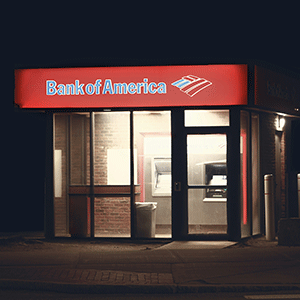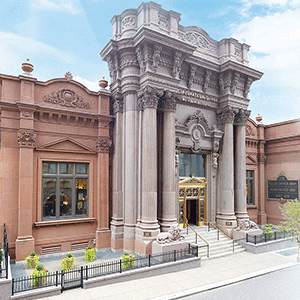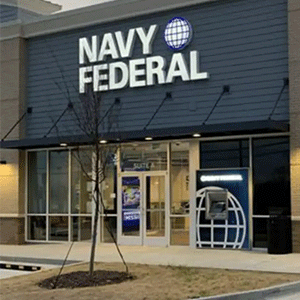Table of Contents |
Financial institutions help move money around the United States; they serve as the infrastructure to shift money as a means of exchange around the U.S. economy. They are regulated by the Federal Reserve and provide financial services to both businesses and customers. They impact the money supply in the United States; this, in turn, impacts the rate of growth and the overall general well-being of the economy.
There are many different types of financial institutions, so let’s take a look at those now.
 Commercial banks are financial institutions that provide everyday banking services to individuals, businesses, and governments. They accept deposits, such as through checking and savings accounts, and use that money to make loans for things such as buying a house, starting a business, or paying for education. Commercial banks also offer services such as credit cards, safe deposit boxes, and money transfers. They play a key role in the economy by helping people and businesses manage their money and access credit. Unlike central banks (such as the Federal Reserve), commercial banks are privately owned and operate to make a profit.
Commercial banks are financial institutions that provide everyday banking services to individuals, businesses, and governments. They accept deposits, such as through checking and savings accounts, and use that money to make loans for things such as buying a house, starting a business, or paying for education. Commercial banks also offer services such as credit cards, safe deposit boxes, and money transfers. They play a key role in the economy by helping people and businesses manage their money and access credit. Unlike central banks (such as the Federal Reserve), commercial banks are privately owned and operate to make a profit.
The following are examples of commercial banks:
 A savings and loan bank (often called an S&L or thrift) is a type of financial institution that primarily focuses on helping people save money and get loans to buy homes. These banks take deposits from customers, like regular banks, but their main goal is to provide mortgages and home loans. Savings and loan banks were originally created to encourage homeownership by making it easier for people to get affordable loans for buying houses. While they still offer savings accounts and other services, they tend to specialize more in real estate lending compared to regular commercial banks.
A savings and loan bank (often called an S&L or thrift) is a type of financial institution that primarily focuses on helping people save money and get loans to buy homes. These banks take deposits from customers, like regular banks, but their main goal is to provide mortgages and home loans. Savings and loan banks were originally created to encourage homeownership by making it easier for people to get affordable loans for buying houses. While they still offer savings accounts and other services, they tend to specialize more in real estate lending compared to regular commercial banks.
The following are examples of savings and loan banks:
 A mutual savings bank is a type of bank that is owned by its depositors rather than by shareholders. This means that the people who put their money into the bank (depositors) are also the owners. Mutual savings banks focus on helping people save money and often provide loans, especially home mortgages. Because they don’t have shareholders to pay dividends to, these banks can sometimes offer better rates or lower fees to their customers. Their main goal is to serve their members’ interests rather than maximize profits.
A mutual savings bank is a type of bank that is owned by its depositors rather than by shareholders. This means that the people who put their money into the bank (depositors) are also the owners. Mutual savings banks focus on helping people save money and often provide loans, especially home mortgages. Because they don’t have shareholders to pay dividends to, these banks can sometimes offer better rates or lower fees to their customers. Their main goal is to serve their members’ interests rather than maximize profits.
The following are examples of this type of bank:
 A credit union is a nonprofit financial cooperative owned and controlled by its members—people who share a common bond, such as working for the same company, living in the same community, or belonging to the same organization. Credit unions offer many of the same services as banks, such as savings accounts, checking accounts, loans, and credit cards, but because they are nonprofit, they often provide lower fees and better interest rates to their members.
A credit union is a nonprofit financial cooperative owned and controlled by its members—people who share a common bond, such as working for the same company, living in the same community, or belonging to the same organization. Credit unions offer many of the same services as banks, such as savings accounts, checking accounts, loans, and credit cards, but because they are nonprofit, they often provide lower fees and better interest rates to their members.
The following are examples of this type of financial institution:
 A nondeposit institution is a financial organization that does not accept regular deposits like a bank or credit union does. Instead, these institutions provide financial services such as loans, investment products, insurance, or financial advice, but they don’t offer checking or savings accounts where customers can keep their money.
A nondeposit institution is a financial organization that does not accept regular deposits like a bank or credit union does. Instead, these institutions provide financial services such as loans, investment products, insurance, or financial advice, but they don’t offer checking or savings accounts where customers can keep their money.
The following are examples of this type of institution:
IN CONTEXT: Types of Financial Institutions
Commercial Banks
Mohammad could open business checking and savings accounts here to manage his daily cash flow. He might also get business loans or a line of credit to buy equipment or cover seasonal slow periods. Commercial banks often offer credit cards tailored for businesses too.
Savings and Loan Banks
If Mohammad wants to purchase or renovate a building for his HVAC business, a savings and loan bank might offer competitive mortgage loans or home-equivalent financing since such banks specialize in real estate lending.
Mutual Savings Banks
Mohammad could use mutual savings banks to save his business profits in interest-bearing accounts. Because they are owned by depositors, he might benefit from better rates or personalized service. He could also get loans for business expansion.
Credit Unions
If Mohammad qualifies to join a credit union (for example, through community membership or industry connections), he could access lower interest loans, affordable business credit cards, and personalized customer service that might be friendlier or more flexible than traditional banks.
Nondeposit Institution (Finance Companies)
For quick financing without strict deposit requirements, Mohammad might use finance companies to get equipment leases, business credit cards, or short-term loans. These can be easier to qualify for but sometimes come with higher interest rates.
By working with a mix of these institutions, Mohammad can access a broad range of financial products suited to different needs, from managing daily expenses to investing in growth and equipment.
So, what are some of the banking services that these different institutions provide? These are the services that banks, savings and loan associations, and credit unions will typically offer their customers or members:
| Service | Description |
|---|---|
| Checking | A checking account lets customers easily deposit and withdraw money for everyday transactions, such as paying bills or buying groceries. |
| Certificate of deposit (CD) | A CD is a savings agreement where you deposit money for a fixed period—anywhere from a few months to several years—and earn a guaranteed fixed interest rate during that time. |
| Line of credit | This is the maximum amount a bank agrees to lend to a business or an individual. You can borrow up to that limit whenever you need, as long as you repay it on time. |
| Letter of credit | This is a bank’s promise to pay a third party on your behalf if certain conditions are met and is often used in business deals. |
| Revolving credit agreement | This is a flexible line of credit with no set repayment schedule, allowing you to borrow, repay, and borrow again up to the credit limit, like a credit card. |
| Point-of-sale (POS) terminal | This is an electronic device businesses use to process payments, such as the card reader or register at stores. |
| Automated clearinghouse (ACH) | This is an electronic system that moves money between bank accounts and is commonly used for payroll deposits or automatic bill payments. |
| Electronic check conversion | This is a process that turns paper checks into electronic payments, speeding up fund transfers so that businesses don’t have to wait for days for checks to clear. |
| Electronic funds transfer (EFT) | The electronic movement of money between accounts at banks, savings institutions, or credit unions makes transfers faster and more convenient without physical cash or checks. |
| Zelle and other digital payment services | Fast, secure apps and services such as Zelle let individuals and businesses send and receive money instantly using smartphones or online banking, often without fees. |
| Automated teller machine (ATM) | ATM is a machine available 24-7 that lets customers withdraw cash and perform basic banking tasks from almost anywhere. |
As you can see, financial institutions provide many services that we use every day. Therefore, banks and financial institutions are an important part of our economy.
Source: THIS CONTENT HAS BEEN ADAPTED FROM RICE UNIVERSITY’S “INTRODUCTION TO BUSINESS”. ACCESS FOR FREE AT OpenStax. LICENSE: CREATIVE COMMONS ATTRIBUTION 4.0 INTERNATIONAL.